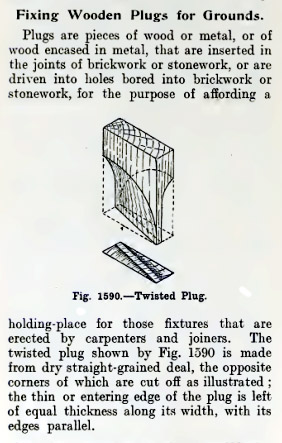bugbear
Established Member
My guttering down pipe has come away from the wall, because
the old wall plugs have just dried out.
Does anyone have an old carpentry book giving instruction
in this old fashioned way of fixing "stuff" to walls?
I know you use an axe to shape a block with a twist, so that
as it is hammered into a rectangular hole, tension
is created.
But I would appreciate info on sizes, amount of twist,
chosen timber etc (and, of course, the "unknown unknowns"... )
BugBear
the old wall plugs have just dried out.
Does anyone have an old carpentry book giving instruction
in this old fashioned way of fixing "stuff" to walls?
I know you use an axe to shape a block with a twist, so that
as it is hammered into a rectangular hole, tension
is created.
But I would appreciate info on sizes, amount of twist,
chosen timber etc (and, of course, the "unknown unknowns"... )
BugBear

































